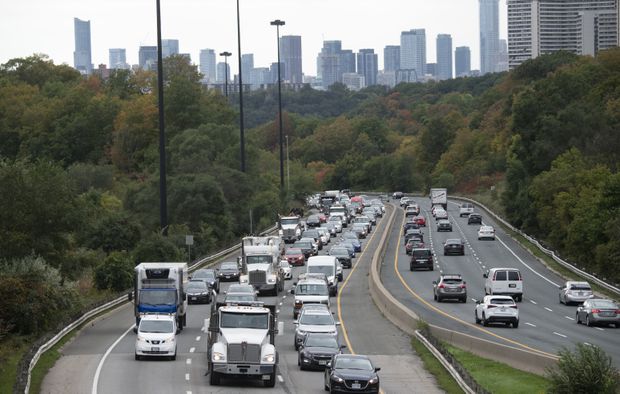
Rush hour traffic on the northbound Don Valley Parkway in Toronto on Oct. 5. The authors of a government-funded report on Canada’s climate goals say the country is at risk of leaning too much on short-term solutions that promote more efficient use of fossil fuels, rather than focusing on a transition to the non-emitting energy sources needed for net zero. FRED LUM/THE GLOBE AND MAIL
Canada is on pace to fall well short of its emissions goals, according to a new government-funded report that says the country’s current strategies will reduce its greenhouse gas output by only 16 per cent, relative to 2005 levels, by 2030 – a far cry from the 40-per-cent cut that Prime Minister Justin Trudeau has promised.
The report also says that Ottawa’s recent commitment to achieve net-zero emissions by 2050 necessitates rethinking some of the techniques for meeting the 2030 target. As of now, the authors say, the country is at risk of leaning too much on short-term solutions that promote more efficient use of fossil fuels, rather than focusing on a transition to the non-emitting energy sources needed for net zero.
The report will be released on Wednesday by the Montreal-based Trottier Energy Institute, known for its clean-economy energy forecasts. The work was sponsored by Natural Resources Canada, along with the Trottier Foundation.
The new analysis comes as Mr. Trudeau prepares to tout Canada’s emissions goals at next month’s landmark United Nations climate summit, COP26, in Glasgow. Trottier’s research stands to increase pressure on his Liberal Party to move swiftly on the climate-related promises it made in its recent campaign platform. Some of those pledges, such as sales quotas for electric vehicles and a cap on oil-and-gas-sector emissions, will be complex and contentious to implement.
The report also underscores the need for greater clarity about the expected emissions-reduction impacts of the Liberals’ policies.
A lack of such transparency to date may help explain why the report is less optimistic than other recent climate modelling by outside experts. Some previous reports have found Canada on track to meet its prior commitment to a 30-per-cent emissions reduction, relative to 2005 levels, by 2030.
In an interview, two of the Trottier report’s authors said they did not include impacts from federal climate-related policies that don’t have specific emissions-reduction aims. Those include, for example, the new federal $8-billion Net Zero Accelerator industrial fund. The government has not specified how much money from the fund will go toward decarbonizing existing industry (which would reduce national emissions) and how much toward attracting clean-technology manufacturing (which might not).
“There’s been a lot of money spent in recent years without that much result,” said Normand Mousseau, the Trottier Institute’s academic director. “So you need to construct the programs in a much more efficient way.”
Trottier’s pessimism, relative to previous reports, also likely owes to its modelling, which only includes policies that the government has implemented, not those it has merely promised. (One notable exception is that the study does factor in planned carbon pricing increases through this decade, which are the biggest driver of the projected 16-per-cent reduction.)
For hitting the 2030 target, the report highlights some relatively low-hanging fruit. That includes commercial and residential buildings, which account for about 10 per cent of national emissions, and which the institute’s modelling suggests “can be decarbonized at relatively low cost with current technologies.”
Although carbon pricing will help reduce the climate impact of buildings by encouraging a shift from fossil fuels to electrical heating, the report says the building sector is on pace for only a 13-per-cent reduction of its emissions by 2030, despite potential for 32 per cent. The reasons for the shortfall include high upfront costs for renovations. This makes clear the need for a comprehensive building retrofit strategy, including new incentives and regulations, which the Liberals promised in their platform.
Less encouragingly, the report finds limited potential for greenhouse gas reductions this decade from transportation, which accounts for approximately a quarter of all national emissions. That’s partly because large freight, responsible for about half of transportation emissions, is “the most challenging sector to decarbonize today.” And the shift to electric passenger vehicles, even if helped along by the promised sales quotas, will happen fairly slowly because of gas-fuelled vehicles’ long lifespans.
That means the route to a 40-per-cent emissions reduction by 2030 unavoidably goes heavily through large industry – and in particular the fossil-fuel sector, which is a top-two contributor to national emissions, alongside transportation.
“In a cost-optimal net-zero pathway, oil and gas production bears the brunt of reductions before 2030,” the report says. Without reducing that production, it adds, extremely costly and dramatic change would be required everywhere else to hit the targets.
As the report implicitly acknowledges, the Liberals will have to balance the imperative to reduce fossil-fuel emissions with concerns about exacerbating regional tensions involving oil-producing provinces. The process of implementing the party’s campaign promise to impose shrinking caps on the oil industry’s emissions, among other measures, will test the government’s ability to strike that balance.
That challenge could be all the greater if policies to reduce those emissions this decade are designed with the 2050 net-zero goal in mind.
While the oil-and-gas industry has been pinning its hopes on carbon capture to reduce its footprint, the authors are skeptical about that prospect, not just because the technology’s costs remain high. They concede that carbon capture will have a big role in achieving net zero, and that it will account for at least 125 megatonnes of annual abatement eventually. But they contend that the technology would be better used to counterbalance unavoidable emissions from sectors that we will continue to rely on, such as agriculture.
The report also rejects the notion of natural gas as a “transitional fuel” – including in electricity generation, as a replacement for coal – which the industry and Western provinces are touting. By the institute’s analysis, sustained gas use is not aligned with the structural change needed to hit the long-term emissions target in a cost-efficient way. The report downplays the potential of measures to reduce natural gas’s carbon intensity, such as by introducing a greater share of renewable gas into the fuel mix.
There are other areas in which the 2050 goal requires imminent structural investment that the 2030 target alone does not. The report says that “the massive increase in total demand for low-carbon electricity that comes with a net-zero society will need to be met one way or another and planning and investment will have to start very soon.”
That investment may not pay off in significant short-term emissions reductions, which have been the main focus of clean-electricity investments (including Liberal platform promises) to date. But it will be needed to meet what the modelling projects will be a rise in electricity’s share of Canada’s energy mix from 23 per cent today (and 27 per cent in 2030) to 53 per cent in 2050.
Broadly, the report suggests that to reach net zero, Ottawa needs to focus its efforts on industry, energy providers and “the private sector in general.” That’s because, as a result of the way Canada’s economy is structured and the way domestic emissions are counted, less than 20 per cent of greenhouse emissions are attributable to “citizens’ direct choices,” mostly around vehicles and home heating.
The good news, the report says, is that because of the rapid evolution of clean technologies, the projected financial costs of reaching net zero are falling significantly. They are already less than they were when the Trottier Institute explored emissions-reduction scenarios in another report three years ago.
There appears to be no time for Mr. Trudeau’s government to waste in putting sectoral strategies in place to steer that transition – both to meet the 2030 target to which it has committed, and to avoid Canada scrambling closer to 2050.
“The more we delay,” Mr. Mousseau said, “doing a crash transformation will wind up costing more.”
ADAM RADWANSKI
The Globe and Mail, October 6, 2021


